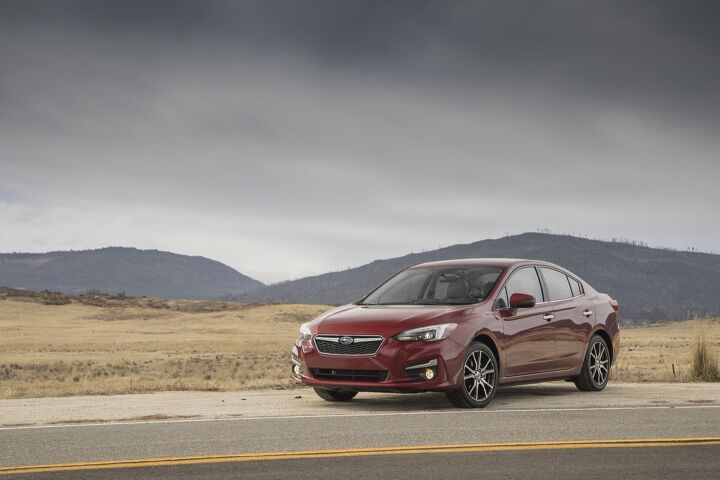Subaru Quarterly Profits Rise Because Of America, But It Could've Been Even Better
Global Subaru operating income rose 19 percent to $1.06 billion in the quarter ending June 30. Net income was up 4 percent to $733 million on an 11-percent revenue increase to $8.9 billion.
Why?
Subaru’s long since gone to look for America. And while U.S. auto sales keep on slowing — falling for a seventh consecutive month in July 2017, for example — Subaru’s U.S. sales keep on rising. July, in which Subaru begins the current fiscal year’s second quarter, was Subaru’s 68th consecutive year-over-year monthly increase.
The U.S. market generated six out of every ten global Subaru sales between April and June.
According to Subaru chief financial officer Toshiaka Okada, “There is a shift to SUVs from sedans,” Automotive News reports. “In that sense, that is a tailwind for us. As we mainly focus on SUVs, the growing popularity of SUVs is a good thing for us.”
But Subaru isn’t just experiencing improved U.S. sales because of its three-pronged crossover lineup. The launch of the new Subaru Impreza has been a particular success by Impreza standards, as well. Through July, year-over-year Impreza volume is up 45 percent as Subaru now generates its Impreza supply from the company’s Indiana assembly plant.
Utility vehicles are Subaru’s mainstay, however. The Outback, Forester, and Crosstrek — a trio of high riders — rank No. 1, No. 2, and No. 3 on Subaru’s U.S. sales charts. Collectively, the trio is up 8 percent this year despite the Crosstrek’s transition into a new generation this summer. The three crossovers account for 71 percent of Subaru’s U.S. volume.
Outside the U.S., Canadian sales in Subaru’s first fiscal quarter were essentially flat, Automotive News reports, while Chinese volume plunged 16 percent and European volume fell 4 percent. China and Europe account for just 3 percent of the brand’s global volume. Subaru’s Japanese sales rose 30 percent, but there, too, Subaru generated substantially less volume in the entire quarter than Subaru USA reports each month.
Yet the positive impact Subaru’s U.S. efforts had on the company’s bottom line would have been even better had the market not taken a downturn and become more competitive. Sure, Subaru is selling more new vehicles than ever before, but they’re also resorting to a rapidly escalating level of discounts the company didn’t have to utilize in the past. Subaru is still notoriously tight-fisted when new vehicle purchase negotiations begin — incentives in July were lower than any other major automaker and 72-percent below the industry average, according to TrueCar.
But Subaru incentives were also 51-percent higher in July 2017 than in July 2016, an additional $342 per-vehicle discount that ate into what would otherwise have been even more substantial black ink improvements.
Not surprisingly, Subaru is content at the current incentivization levels, well below rivals as they are. “Overall, our incentives stay within our expected levels. For now, we are not going to change our incentive program significantly going forward,” Okada says, “as our sales have been good.”
[Image: Subaru]
Timothy Cain is a contributing analyst at The Truth About Cars and Autofocus.ca and the founder and former editor of GoodCarBadCar.net. Follow on Twitter @timcaincars.
More by Timothy Cain
Latest Car Reviews
Read moreLatest Product Reviews
Read moreRecent Comments
- Theflyersfan If this saves (or delays) an expensive carbon brushing off of the valves down the road, I'll take a case. I understand that can be a very expensive bit of scheduled maintenance.
- Zipper69 A Mini should have 2 doors and 4 cylinders and tires the size of dinner plates.All else is puffery.
- Theflyersfan Just in time for the weekend!!! Usual suspects A: All EVs are evil golf carts, spewing nothing but virtue signaling about saving the earth, all the while hacking the limbs off of small kids in Africa, money losing pits of despair that no buyer would ever need and anyone that buys one is a raging moron with no brains and the automakers who make them want to go bankrupt.(Source: all of the comments on every EV article here posted over the years)Usual suspects B: All EVs are powered by unicorns and lollypops with no pollution, drive like dreams, all drivers don't mind stopping for hours on end, eating trays of fast food at every rest stop waiting for charges, save the world by using no gas and batteries are friendly to everyone, bugs included. Everyone should torch their ICE cars now and buy a Tesla or Bolt post haste.(Source: all of the comments on every EV article here posted over the years)Or those in the middle: Maybe one of these days, when the charging infrastructure is better, or there are more options that don't cost as much, one will be considered as part of a rational decision based on driving needs, purchasing costs environmental impact, total cost of ownership, and ease of charging.(Source: many on this site who don't jump on TTAC the split second an EV article appears and lives to trash everyone who is a fan of EVs.)
- The Oracle Some commenters have since passed away when this series got started.
- The Oracle Honda is generally conservative yet persistent, this will work in one form or fashion.



































Comments
Join the conversation
They've come a long way and are much better than they were. I owned a WRX and got rid of it because it was so cheap feeling. I loved the performance, but tired of a car that felt like a tin can.
"Through July, year-over-year Impreza volume is up 45 percent..." Do you mean the Impreza hatchbacks? I thought overall Impreza sales (combined sedan and hatch) were only up 29.9%.